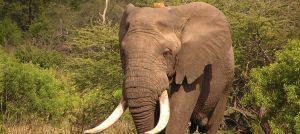
On the 31st October 2013, the Section Ranger at The Kruger National Park, Karien Keet, reported that a large tusked elephant had been found dead. Further examination of the recovered collar revealed that the carcass belonged to Mac, a magnificent bull who we first collared in 2002 and whom we have been monitoring ever since.
Just four months prior to his death, Mac had completed his annual musth cycle in the Associate Private Nature Reserves. Each year, for the past 10 years, we have had the delight of meeting Mac in his testosterone-charged state whilst in full musth. He would have to walk approximately 200km from the northern regions of the Kruger National Park to reach us in the Associated Private Nature Reserves.
His powerful presence always seemed to mask any indication of the arduous journey he had just completed. His rhythmic swaying as he walked to accommodate his tusks, each weighing over 100llbs, was mesmerising to watch.
Magnificent tusks
By the time we got to the Kruger National Park, Mac’s splendid tusks had already been removed and sent to the headquarters for safekeeping. The right tusk measured 2.47m in length, and the left tusk was 1.94 m. The circumference of each tusk was approximately 50 cm. His tusks were silky and reminiscent of a whale’s ribs, both in size and curvature. They also seemed strangely out of place lying on the concrete floor, as if the essence of what they represented was no longer part of them. After viewing the tusks we set out to find the carcass, some 21km from where his collar had transmitted its last reading. With a heavy heart we set out to establish the cause of death.
Kruger National Park’s Section Ranger, Karien Keet stands behind Mac’s incredible ivory
Cause of death
We approached the collapsed bulk of the fallen giant with apprehension. We examined the carcass for any signs of injury or bullets, making use of a metal detector. Fortunately, he appeared not to have been poached. Next we looked at his teeth and found that an abscess in the upper left molar had caused almost no wear to his lower left molar while his right molar was worn smooth due to excessive use. With so little grinding surface left for Mac to masticate the brittle late dry-season browse, he was probably unable to regain his body weight after his recent musth cycle. In all probability, he had starved to death-a fate that befalls many an old elephant around the age of 60.
Abscess on the upper left jaw
The fight continues
As we walked back to the vehicle, the budding leaves of the Mopani glistened in the sun. Bright green blades of grass stabbed through the tangled grey mass of the previous wet season’s lifeless tufts of grass. The rains had come, but the relief they brought were too late for Mac. What I remember of Mac was nowhere to be found at his crumbled carcass. I now only have the fond memories of him splashing himself with mud with sheer delight or watching him close his eyes in bliss as his great jaws crunched down on the tender shoots of a new wet season’s growth.
Had we not fitted him with a satellite collar more than a decade ago, we would never have known just how regularly he came south each year in search of females. We would not have known, when we last took tooth moulds of him in 2010, that he was close to his mid-fifties. Never would we have imagined that his total home range exceeded 7000 km2 (minimum convex polygon method) and we would never have had the privileged of measuring his tusk growth with each successive collaring operation.
Although a great sense of loss came over me, it was accompanied by an incredible sense of gratitude that I had the privilege of following the movements and life of one of the last remaining large tusked bulls in Africa. Mac represents the longest continually tracked elephant bull in Africa and is one of the largest tuskers ever collared.
There are but a handful of bulls of his stature left in Africa today. Sadly they have become targets of man’s greed and unnecessary quest for ivory. Mac was the ambassador of a project that officially started with his collaring 10 years ago. I hope that even in his death he will continue to remind us how vulnerable elephants are, especially those with large tusks. With ivory poaching taking a heavy toll on elephant populations to the north of our borders, we will do well to remember that elephants’ survival will depend on the political goodwill of many nations to safeguard them to the best of our ability.

